Connie Bombaci's Blog, page 4
August 4, 2020
Nippy Deaf Dogs

I often receive many questions about what to do when a deaf dog exhibits certain types of behavior. What I first tell folks is that working with a deaf dog or puppy is no different than working or training a hearing dog. Only the method of communication needs to change which includes ways to get their attention. In working with families of deaf dogs and members in the Deaf Dogs Facebook group, I discovered great thoughts and ideas gained as they lived with their deaf dogs. I offer some of their responses and suggestions as a means to help others be successful in training their deaf dogs.
Nippy Pups
Question: What do I do with my 10-week-old, deaf pup who is nippy? Deaf Dogs Member Responses:Holl Doll: Whenever my Stevie girl gets nippy, I hold up my hand in a stop. If she keeps getting nippy, I walk away or put her in time out. The stop sign works now. Like a "talk to the hand" type signal reward when he's not biting!!! Lots of love and attention, and as soon as he bites, he gets ignored!
Mike Clarke: Talk to the hand, as well as an ASL “NO” worked for both of mine! Some of the biting is teething, some are just how dogs and other canines test limits. Firmness, consistency, and love are the answers.
Connie Bombaci: This is the age of teething as well as establishing oneself in the pack. Use a sign with consistency. Mama dogs poke their pups on the side of the neck as a correction. I have used this technique with a very gentle poke - more to get Judea's attention - and then add the sign.
A tired dog is a good dog. Wear him out often.
Tethering a young pup to us during the time of training or housebreaking is a great way to nip the problem as soon as the behavior begins.
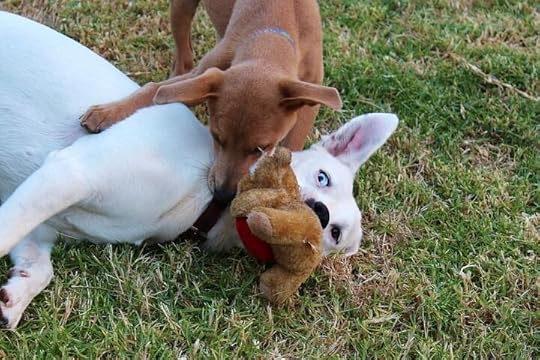
Sandy Davis Taylor: Being nippy is totally normal for a dog that age. Since he is deaf, he couldn't hear his litter mates yelp and so he doesn't know what is too hard. He will outgrow it and puppy teeth are so much sharper. One thing is you have to talk to your daughter about her reaction. My son would scream and wave his arms. I had to convince him that was only encouraging our dog because that was fun to him. I also kept him on a long leash in the house so I could correct him before he got "worked up". Even though he is deaf, be sure to talk with him just like any dog with a firm No! and pick a hand signal for no. Even though he is deaf he can pick up vibrations and read expressions. Lastly, have a toy he likes to chew always at the ready during interactions to put in his mouth as an acceptable thing to bite. I know its hard, I was on the brink of re-homing my dog due to biting, but he is 6 months now and sweet and I'm glad we hung in there.
Debbie Butera: My boy still does that at times. But never to me. He knows I do t tolerate it and I’ll walk away from him. My girls (they are older 14/24) fuss with him, so he leads with his teeth. He’s not being vicious, he’s playing rough like they do. They will walk by him, and if he wants to play, he will nip at their butt (which is kinda funny).
I don’t tolerate it, so the minute he starts to jump and nip, I raise my hands and walk away or turn around. It will be harder for you, mom, cause your little person is young, but if you see it starting, tell her to turn her back on the pup and calmly walk away (do not run). That’s my two cents.
Seeking more ideasIf you have any additional thoughts, ideas, or suggestions, please email hoganshopebook@gmail.com
May 11, 2020
Hogan's Hope for a Safe Puppy Home - Part 2
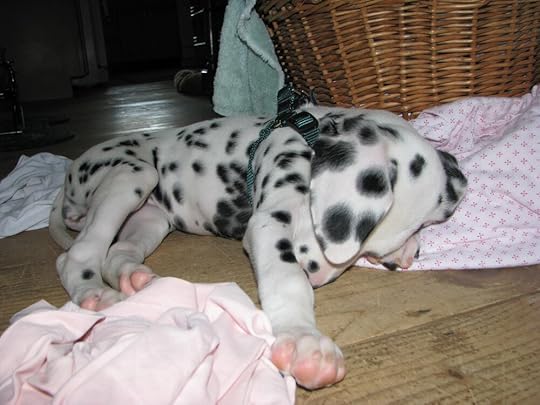
Our puppies are our innocent, precious family members who depend on us for their every need.
Okay! Your wonderfully precious puppy is home, and the real fun begins. New puppies need an enormous amount of time, energy, patience, and love. Bringing a puppy into our homes takes more effort than many people realize. However, with a solid understanding that we are in for an amazing life with a pup who truly accepts and loves us no matter what, the rewards are immeasurable.
1) Remembering that, no matter what’s going on, our furry, four-legged little girl or boy is a genuine member of our families is crucial. Every pup comes with his or her own unique personality which is complete with deep feeling. We are totally responsible for their care, loving attention, and empathetic compassion and consideration. We are their protectors and must safeguard their physical and emotional well-being in every situation.
2) Ensuring safety is paramount. Getting our homes ready for their arrival was step one. (See Blog: Part One) Create a safe room or area for everyone to enjoy each other that is free of dangerous objects, wires, or possible accidents.
3) Equipping with identification makes certain that our furry family members can always be brought home. Embroidered collars with cell phone numbers are great because a tag might get lost. Some people have chips placed in their pups to ensure permanent identification that can be registered and scanned in the event of getting separated from us. Fenced yards, leashes, appropriate collars, and harnesses for the size and breed, shelter, and risk-free toys are only a few of our considerations. Absolutely no metal collars or outdoor chains – I could write a book on the dangers of both. If we wouldn’t do something to our human children, then it’s best not to do it to our pets.
4) Establishing a solid method of communication is key. Choose what words are going to be used for what requests and how the words are going to expressed—words, hand signs, both. Teaching American Sign Language, even to hearing dogs, is extremely useful when the spoken word can’t be used (across a field) or when our pup becomes hard of hearing in later life.
5) Teaching our children to be gentle, kind, and part of our pups’ care guarantees the cohesiveness of the pack. Children can also learn to properly pick up a puppy by supporting the entire body and not walk around with a dangling puppy. Again, ask, “How would we want someone to hold our baby or child?”
6) Training begins as soon as our puppy arrives home. This includes housebreaking. “Accidents” are ours, not the puppy’s. Taking our new pup outside to the same spot every half hour for the first 24 hours is a great way to begin. Like I said earlier, it’s going to be a lot of work, diligence, and dedication….and more time than most people imagine, but it is definitely worth every loving second of our efforts. Too many adopt a puppy and give up, abandon, or re-home when they get frustrated or tired of the novelty.
7) Keep in mind that puppies need to go potty about 10-20 minutes after eating. Be attentive and diligent.
8) Adjusting our schedules is a necessity. Puppies cannot hold their bladders for hours. The “rule of thumb” tends to be that a puppy can hold their bladder for the number of hours that they are in months. So, a pup who is two months old can hold their bladder for no longer than two hours. This, too, needs to be adjusted for every little one. It could be a shorter period of time.
9) Feeding needs to be three or four times a day. Food should not be limited for a growing pup. The correct diet and amounts need to be determined with our veterinarians’ help before we bring our four-legged family member home or at the time of their first medical checkup. We should buy the highest quality food that we can afford. Keep asking yourself what you would do for your children. I highly recommend that food not be left down all the time. Sure, this habit makes it easy for us but creates grazers. Let the pup eat until full, and when the bowl is left, pick it up, usually within minutes. If the pup seems like a fussy eater, be patient. Feed at the next mealtime. I guarantee that puppies will eat well if hungry. Another advantage of not creating grazers is that our pups will be more food-oriented and easier to train using delicious treats.
10) Securing our yards is imperative.
11) Checking our yards for dangers including poisonous plants and other potentially unsafe areas, objects, or substances. Many lawn fertilizers are hazardous.
12) Preventing theft or dangerous situations can be real lifesavers. Being left unattended in a yard or vehicle are extremely hazardous in more ways than can be listed. Unfortunately, too many dogs have been kidnapped from the safety of beautiful suburban yards.
13) Lastly and most importantly, being absolutely sure that you think before you adopt. Abandoning a dog at a shelter or another home deeply impacts the heart and nature of an animal. Our dogs of all ages are very capable of experiencing the same sadness, confusion, and heartache as any one of us. We are responsible for the well-being and care of one of God’s incredible and loving animals.
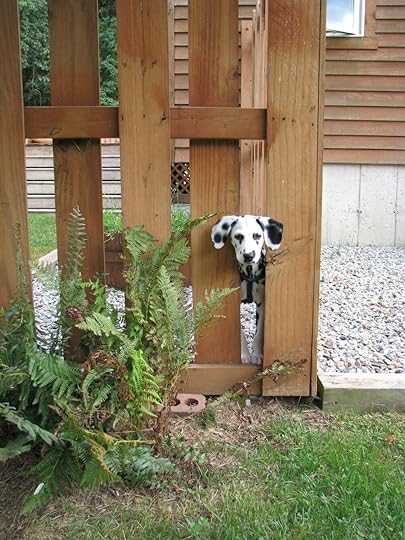
Fences need to be checked for possible escape or getting little heads caught. Never leave your puppy outside unattended or without constant supervision.
April 30, 2020
Hogan's Hope for a Safe Puppy Home - Part 1
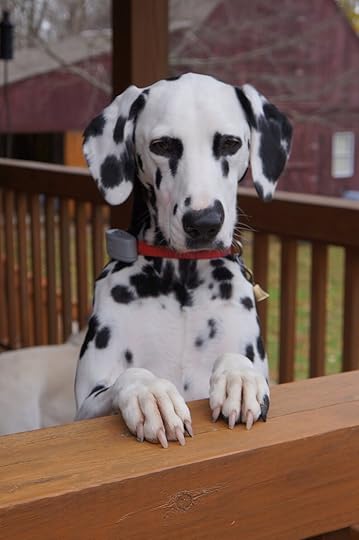
I have had the wonderful life of working with and training dogs since I was nine years of age. My father brought home our first family pup who we named Victoria. Of course, we called her Vicky for short. She was a devoted pup from the get-go, and my father believed that a good dog was a well-mannered dog. To this end, he began her training as soon as she came into our home and taught me everything that he knew. And…he knew a great deal.
Vicky learned fast and easily because of her high level of intelligence and intense desire to please. She loved us with all her heart and dedicated herself to our protection. I could tell you several stories where she quite literally saved the day, but that’s for another time. Well, okay. So not to keep you hanging, she relentlessly dragged my mother by the arm out of the basement where Mama was doing the family laundry. There was an electrical fire that started in the wall on the first floor. If it weren’t for Vicky, my sister and I would have been trapped on the second floor. The fire fighters gave Vicky all the credit for saving the family. This is only one of several times that our beautiful girl protected and saved her beloved family.
The days before bringing Vicky home were filled with excitement and preparations for our new, four-legged furry family member.
Part 1: Puppy Proofing the HouseSecure cabinet doors so noses and paws can’t open them.
Relocate all dangerous items such as cleaning solutions and powders, sponges, hair products, onto higher, out-of-reach shelves.
Replace trash cans with tight fitting lids. Garbage can be extremely dangerous with the bones, plastic wraps, aluminum foil, sharp edges created by chewing on plastic containers. Intestines can be perforated or blocked with life-threatening emergencies.
Place clothes hampers in strategic locations. All dirty socks, underwear, and odorous clothing must be kept completely out of reach. Puppies love us and any item that has a strong scent of us is appealing to them.
Designate a safe place for shoes. Shoes are a great chew toy for our puppies, especially since our feet smell delightful to them. Think about creating a safe, special shelf just inside the back door for shoes to be placed as soon as you come in the house. Remember to keep closet doors closed tightly.
Make a safe place for your puppy to sleep. Puppies need a bed of their own to sleep and feel secure. The bed and possibly a crate do not need to be overly large. It only needs to be large enough for your pup to stand and turn around. Purchase a crate that is the size needed when full-grown. Use dividers to make the interior smaller and gradually increase the area as your puppy grows. This gives the feeling of security, like a den. It also keeps your pup safe when you need to leave the house for limited amounts of time. He or she won’t be able to run throughout the house and get into trouble by chewing on wires, cushions, or other things. Since dogs don’t like going potty in their beds, it will help with housebreaking. Do remember to take your pup outside immediately upon arriving home and/or taking him or her out of the crate.
Designate a safe play area. Some folks like obtaining Xpens (exercise pens that are usually collapsible) that are like a play pen for toddlers. It keeps your puppy safe while you’re busy with things around the house. But don’t overly confine your puppy; our “children” are members of our families who want and need to be included and part of our ongoing activities.
Choose a high quality food. Quality and price are not necessarily in the same equation. Talk with your veterinarian and select the highest quality that you are able to afford. Remember to never underfeed your growing puppy, and feed him or her at least three (3) times a day. Feed until satisfied. I also recommend that food not be left down so they can graze. You want your pup to be happy and healthy as well as eager to receive a reward during training.
Obtain food and water bowls that are non-slip, stainless steel or lead-free stoneware or ceramic. Bowls need to be easily cleaned as well as sanitized! Wash food bowls thoroughly after every meal to eliminate bacteria, and wash water bowls and fill with fresh water often.
Buy durable and appropriate collar, harness, and leash. Different sized dogs need different collars and/or harnesses. For instance, a very small dog is better outfitted with a harness for attaching a leash than a collar. A collar can also be used but function more as decorative attire and for ID tags. Harnesses with a back clip used on larger dogs tend to promote pulling, but no-pull harnesses are now available that are working wonderfully. If you use a collar, I recommend a Martingale collar. It tightens enough so your pup can’t back out of the collar which is a great and very important safety feature. Yet, it doesn’t choke. Please remember that over time, choke collars damage the esophagus! [Note: Proper training techniques eliminate the need for choke collars.] Make certain that the clip is strong and sturdy and won’t break or open.
Get a seat belt. This is non-negotiable! It’s extremely tempting to say or think that we’ll hold our puppy. NO! It’s very simple to attach a seat belt strap to a dog’s harness and then to the seat belt in our back seat. Sudden stops, hard braking, or minor bumps throw our pups and seriously injure them while the humans are safely belted. No one can hold a pup in an accident. Please do not fool yourself or allow anyone to convince you otherwise. Too often, Police officers have witnessed an accident or incident where the humans are fine but the animal suffers great injury. Slamming against a seat can be fatal. Belting a pup only takes a moment. And…the pup can still sit in someone’s lap if that’s the issue. Additionally, air bags kill dogs of all sizes in the front seat.
Order identification tags or have the collar embroidered with your pup’s name and your cell phone number. The embroidered collar eliminates the possibility of tags getting ripped off and keeps your vital information on your pup. [Note: Talk to your veterinarian about having your pup chipped for permanent identification.]
Pick up your children’s toys and make a safe toy box. Puppies love to chew, and destroyed toys not only upset children (and parents) but pose real dangers for pups. Perforated bowels and blockages are life threatening.
Purchase safe play and chew toys. Like our little children, puppies are inquisitive, adventurous, and investigative. Everything is fun, and they like to experience all types of sounds, places, textures, and shapes. Everything also goes into their mouths! Hard rubber toys of all sizes and shapes are wonderful. I suggest KONG and Yapple toys. The ones with a hole can be slathered with a small bit of wholesome peanut butter or cheese. Stuffed toys are a favorite of dogs BUT must be monitored very carefully. Let your pup play with them only when you can supervise. Monitor to make sure that the stuffing can’t be ingested and cause intestinal blockages or irritations. Put these toys away when you are not with your pup. Safe items are available that simulate heartbeat and warmth and can be used during the transition away from litter mates. The adjustment can be distressing, and these are reported to help in some situations. (I have another admission - I always allowed my pups to sleep with us at night. By tethering them to me, their movement alerts me, and I take them outside. I keep them tethered to me until I am sure they were potty trained.)
Think about house breaking before your puppy comes home. Rules of thumb: 1) A puppy can only hold their bladder for the number of hours equally their age in months. A two-month old puppy can only wait two hours at the most - it can be shorter. 2) Take your puppy out 10-20 minutes after eating.
Next Blog - Part 2: Puppy Arrives HomeApril 9, 2020
Foods, Plants, and Other Things Our Dogs Can't Eat
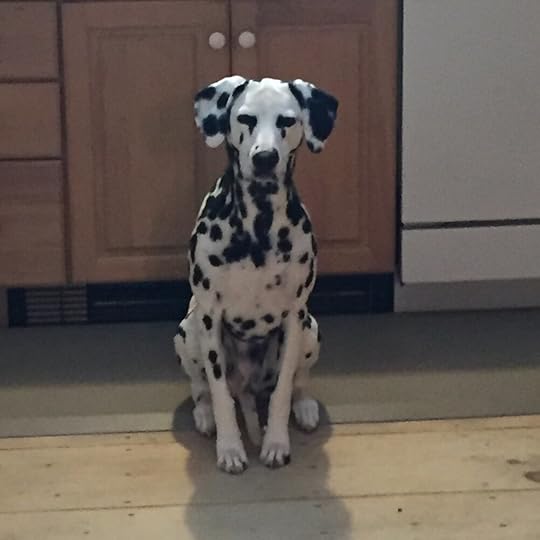
Judea, our deaf dog, who loves to run, play, cuddle, and take walks.
If you are anything like me, I read, read, read, and read some more to make sure that I am doing everything that I possibly can to keep my precious Judea safe and healthy. Having her live the longest and healthiest life is my ultimate goal, wanting her with me for many years to come. And I’ll do anything to make that happen. Often, I come across articles with great information about the food or plant items that pose dangers and have been offered a comprehensive list by Chinaza Ekwuribe, “All things dog and beautiful,” to share with everyone. I hope that you find this as a fast, go-to guide. Be sure to visit the complete article which gives great supplemental information on each item.
“There are none so deaf than those who refuse to listen.”
The link to the complete article: 197 Items dogs can't eat
Table of Contents
14. Artificial Sweetener (Xylitol)
15. Salt and Salty Snacks or Foods
April 2, 2020
Guide to Training our Puppies - Hearing or Deaf Dogs
I am always extremely humbled and honored when an expert reaches out to me and offers great information to share with our readers. Helping each other creates a special relationship, a positive bond that I believe is so important to creating wonderful lives enjoying our friendships. And, sharing our experiences and thoughts about our precious dogs is just about the BEST!
I hope that you enjoy this article given to us to post. The information is pertinent for hearing and deaf dogs — dogs of all types, shapes, sizes, genders, and abilities. We only need to adapt according to our dogs needs. No need for “rocket science.”
Thank you, Sean Farrell, for reaching out and providing us with this wonderful information and guide.
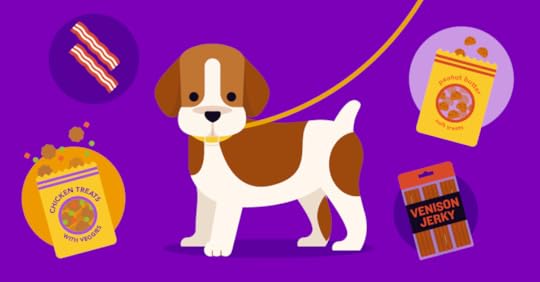
We’ve all met dogs that aren’t the best behaved. They might jump. They might be rude to other people, such as small children. They might pull hard on a leash or eat food off of a table. Those dogs aren’t any fun to be around and even less fun to be part of your family. But a well-behaved dog? Well that’s something to behold — a dog that you can walk easily and snuggle with and introduce to people. But that well-trained dog starts not when it becomes an adult, but when that dog is a puppy. So understanding when you should start building your puppy’s repertoire of good skills is important.
The start date? It can be immediate. There are things that your puppy can do when it’s very small. What are those and how can you best help your puppy become a well-mannered adult? This graphic explains it.
Your New Puppy Training Guide: When to Tackle Each Skill
By Caroline Golon
Training is a critical part of your puppy’s growth and development. But when is the right time to start training? The short answer: It depends on the skill. Read on to get a better handle on timing training for your new pup.
Basic Commands
The first phase of training involves basic commands, because it is a foundation for every other type of training. Simple commands such as “sit,” “stay,” “lay down,” and “leave it” are important ways to keep your puppy safe and happy as they explore the world.
Training your pup simple obedience commands can begin as soon as they come home with you, typically around 7 to 8 weeks.
Try to choose an area of your house with as few distractions as possible and keep training sessions to around 5 to 10 minutes, spread throughout the day. Puppies are notorious for short attention spans. Plus, they tire out quickly!
The key to successful puppy training is to make it a positive, fun activity. Do everything you can to maintain a happy, positive energy during each training session. (Though how can you not with a cute puppy bounding around the room?)
While there is no specific order in which to train basic commands, one of the best skills to teach first is “come” because it is a lifelong skill your puppy needs for obedience and safety.
“Sit” is another relatively easy command to teach your puppy, especially if you use rewards and lots of praise. “Lay down” is slightly more difficult to teach simply because puppies are full of energy! Similarly, “stay” can be a bit trickier with an energetic pup, but is another key element of your puppy’s basic training.
Suggestions for Deaf Dogs (from Connie Bombaci):
1) Use American Sign Language so not to reinvent the wheel and allow many others the ability to communicate with your special deaf dog.
2) Teach the sign for cookie first. Your deaf dog will realize that your hands are “saying” something yummy, and your deaf dog will watch you and your hands much more intently.
Potty Training
Potty training should begin as soon as you bring your new puppy home as well.
But remember, potty training your puppy requires time and patience.
It also requires a schedule. Take your pup out every two hours to start, increasing time as he or she gets older. You can even set a timer to keep everyone on track.
Most puppies get the concept of going outside within a few weeks but it’s important to remember that puppies have small bladders. They may not be able to hold it for very long. Puppies can be expected to hold their bladders for the number of hours that corresponds with their age in months. In other words, a five-month-old puppy should be able to hold it for around 5 hours. This is true up until about 9 months when any dog may have trouble holding for longer than 9 hours.
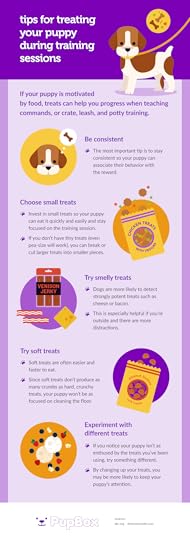
Crate Training
Crate training a puppy is an activity that helps with other aspects of your dog’s training and protects him or her (and your sofas and rugs!) when you aren’t around to supervise. Many dogs grow to love their crates as it represents a safe spot to sleep or get some private down time.
You can begin crate training as soon as you bring your new puppy home, typically around 8 weeks. And because dogs instinctively don’t like to mess where they sleep (we don’t blame them!) they typically hold it while in the crate within a reasonable time frame. At some point their little bladders may not be able to hold it anymore, so be sure to take your puppy out every few hours.
Leash Training
Walking on a leash is not natural behavior for dogs. That’s why puppies often dart in different directions when they first have a leash on. The good news? Leash training your puppy at a young age will build good leash manners for a lifetime.
You can also start leash training as soon as you bring your new puppy home. Put his collar and harness on when he’s running around the house, playing, or being trained. When your puppy goes in his or her crate or is unsupervised, make sure to take off the leash and/or harness so they don’t get tangled.
Once your puppy is used to their harness and collar, it’s time to add the leash. Start by allowing your puppy to drag it around until he or she doesn’t seem to mind it. Then, you can take your pup on short walks around the house. Gradually move the walks to the yard and then, once your puppy has the hang of walking on the leash (i.e. he follows you) you can move on to short walks in the neighborhood. (Just make sure your puppy has the proper rounds of vaccinations before venturing out of the safety of your home.)
When to Teach Your Puppy Additional Skills
Similar to people, dogs are different when it comes to learning. Some dogs pick up training, commands, and tricks right away, while others take a little longer. Before you move on to more advanced skills such as “rollover,” “shake,” “leave it,” or “wait,” make sure you get the foundation down. And remember: Training never really ends. As a pet parent, it’s your job to keep up your training, continually practice known commands, and move on to advanced training as your dog grows.
Conclusion
Training is essential. It builds trust, helps you bond, and teaches critical skills to last a lifetime.
March 30, 2020
Animals do not spread Covid-19
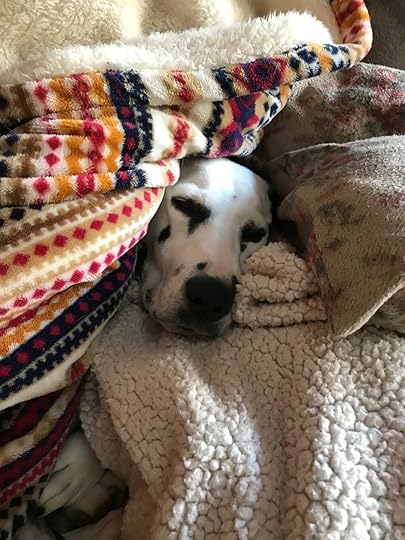
Judea enjoys days at home by cozying up in her mama’s soft blanket.
Our world is fighting a medical warfare, and we are receiving so much information and tips on how to keep safe and healthy. What we need to know is that our precious animals do NOT spread the virus. Covid-19 is a person-to-person transmission. Pets do not need to be abandoned in any way.
Recently, I received an audio recording that listed some of things that we can be doing to help ensure our safety.
Because the Covid-19 restricts airways and lungs with thick mucous these are the tips:
1. Drink lots of hot liquids. Sip warm liquid every 15-20 minutes to wash the virus into the stomach that will destroy the virus.
2. Gargle with saltwater, lemon, or vinegar.
3. Bathe from head to toes as soon as you come in from being out of the home. Do not touch anything or sit down. Any detergent or soap kills the virus. Wash your clothing immediately, and spray your shoes with disinfectant. Go to the shower without touching anything in your home.
4. Wash metallic surfaces very carefully because the virus can last on these surfaces for up to nine (9) days. Be careful about touching handrails, etc. and be sure to wash handles and surfaces at home regularly. In addition, wipe all handles and surfaces in your car as soon as you come home.
5. Don’t smoke.
6. Wash hands every 20 minutes for at least 20 seconds with any soap that foams.
7. Eat fruits and vegetables, trying to elevate zinc levels as well as vitamin C levels.
8. Try to stay healthy, not getting other viruses or colds which weaken the system.
9. Avoid eating and drinking cold things.
10. Be aware of sore throat and perform the above precautions as soon as it becomes symptomatic. The virus passes into the lungs 3-4 days after getting a sore throat.
11. Retrieve your mail with latex gloves and wipe your mailbox. Wipe all mail before bringing it into your home and opening each item.
This is a very important video that outlines how to bring items into the house.
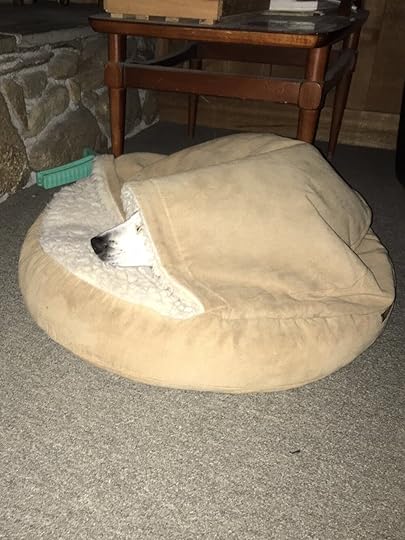
Heidi also enjoys her cocoon.
March 10, 2020
Hogan's Hope: News Article on Deaf Puppy
From Mother Nature Network
MARY JO DILONARDO December 17, 2019
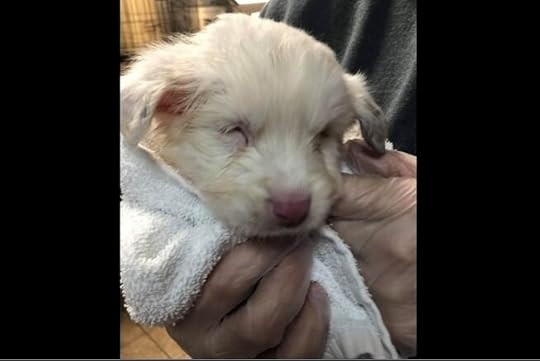
The puppy has been named Starla. (Photo: Speak! St. Louis)
Winter is a tough time of year for our precious animals who are destined to live outside in the harsh elements of cold temperatures, lack of shelter, and little or no food. Mary Jo DiLonardo offers us an uplifting story that warms the heart and hopefully encourages us to be on the lookout for the less fortunate animals who need our love and attention. Special appreciation is given to those who love and accept our animals for who and how they are. Thank you, Mary Jo!
“This time of year, delivery drivers are rushing around, darting in and out of their trucks as they race to drop off packages for the holidays. But one UPS driver picked up a very special package this week on his route in rural Missouri.
He was heading down the highway when he thought he saw something alongside the road. Not sure if he was right or not, he decided to stop, just in case. He found a tiny white puppy nearly hidden in the snow.
He warmed up the little dog in his truck and took it to the local shelter, where they soon discovered that the young Australian shepherd was hearing and vision impaired. She’s likely a double merle.
Merle is a beautiful swirled pattern in a dog's coat. Some disreputable breeders will breed two merles together in hopes of getting popular merle puppies. Those puppies have a 25% chance of being double merle — which results in a predominantly white coat and usually means they have hearing or vision loss or both.
When double merle puppies are born, they are often discarded.
Fortunately, for this little one, a guardian angel in a delivery truck saved the day.
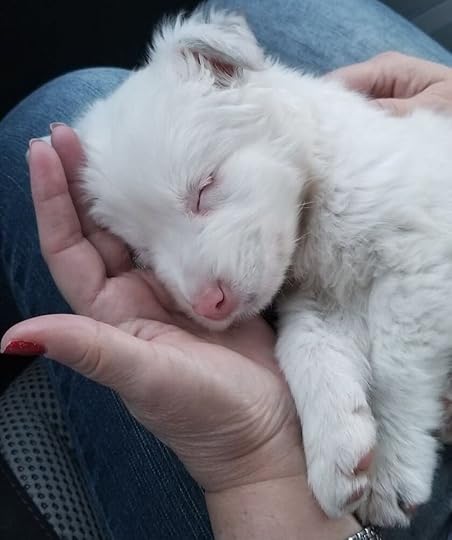
‘We see this all the time’
Starla the rescued puppy sleeps on her way to her foster home. (Photo: Speak! St. Louis)
At the shelter, they knew the puppy would need special care. They reached out to Speak! St. Louis, a rescue that specializes in blind and/or deaf dogs. Volunteers at Speak quickly agreed to take in the miracle puppy; they named her Starla.
The shelter has to hold Starla for a few days just in case someone claims her, but no one really thinks that will happen.
In the meantime, she is being treated for all sorts of worms, which is typical for a puppy. Fortunately she has tested negative for parvo, an often-lethal disease found in young puppies.
‘We see this all the time," Judy Duhr, director of Speak, tells MNN. "These puppies are cast aside because of their preventable disabilities. But they deserve to live a happy and healthy life just like any other dog. Society needs to see their worth.’”
March 7, 2020
Miracles offer us all Hope
By Andrea Powell
A tornado tore through Clifton, Ohio, destroying homes and barns in its path.
John Richardson, a Clifton resident, lost two of his historic barns to the tornado. According to Fox 28, the barns were built in 1861, but now are piles of rubble. However, Richardson witnessed a miracle.
Richardson recalls the tornado approaching: “It came across this field over here and it was just like a sheet of white.” A friend of Richardson’s captured the tornado tearing across the field.
His horse, Freckles, ran back to the barn when the tornado hit. Freckles saw the barn as a safe place, and ran inside to escape the storm. The barn was destroyed, but Freckles stood amongst the rubble untouched. Freckles only had minor scrapes and bumps. He waiting patiently and calmly in the rubble, until he was escorted to
Richardson posted on Facebook, “Please say a prayer for us…A tornado came through while, I was at home today. We lost all of our barns, that have been standing since 1861 and suffered some damage to the house. I’m okay and so are the horses. Freckles was freed from the debris and seems to be okay. It’s a miracle that he is alive.”

Photos by John Richardson
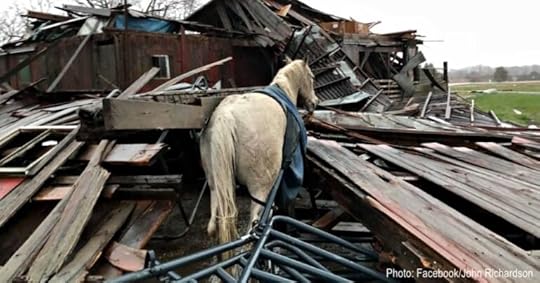
Freckles miraculously unscathed
Photo by John Richardson
How Humans Frustrate Our Dogs
9 Things Humans Do That Stress Our Dogs Out
When we love our dogs like family, we sometimes forget that they don’t understand us quite like our human relatives. Sometimes we try to have full-on conversations with them or unknowingly send them body language signals that are interpreted differently in the animal kingdom. For these reasons, we’ve compiled a list of 9 common things that humans do that stress dogs out.
If you’ve done any of these things, don’t worry–we all have! But by being more aware, we can try to communicate with our canines as clearly as possible. And lucky for us, there’s no limit to their forgiveness!
1. Getting frustrated when your dog acts like…a dog!Dogs bark, dig, chew, sniff, and steal table scraps that are within snout’s reach. To them, it’s natural behavior! (Plus, they don’t understand the value of your favorite pair of shoes.) However, this doesn’t mean your dog should have free reign to do whatever he likes. Instead of punishing these behaviors, they need to be redirected–and this takes patience! Vet Street suggests alternatives such as giving chewers stuffed Kongs to gnaw on, or teaching barkers to learn to use their “inside voice”.
2. Having inconsistent rules and boundaries
Dogs thrive on consistency and routine, and take comfort in it. If your pup is allowed on the couch one week, then scolded for it the next, she will become stressed when she can’t anticipate your reaction to her behavior. She won’t understand if one night you decide to “let it slide” or you allow her to break the rules for a “special occasion.” When you create boundaries, stick to them!
3. Expecting your dog to obey you just because he wants to make you happy
While our dogs love seeing us happy, they’re still animals and opportunists (for instance, if they see an opportunity to snatch some leftover chicken off the counter, they will usually take it!). Some dogs do obey their owners simply to please them, but most of them perform for one simple reason: to receive their reward! Vet Street explains that inconsistent rewarding will most likely lead to inconsistent behavior. And you can’t be angry with your dog for not obeying if he can’t expect a treat in return.
4. Using multiple verbal cues to indicate the same behavior
This one can be a tough habit to break! Say your dog is barking at the mailman, so you say, “shh!” “stop!” and “quiet.” You’ve given her three different commands that are supposed mean the same thing: quit barking! Your dog gets confused so she continues to bark and eventually gets scolded–but she doesn’t know why! The best plan is to come up with specific words to apply to each trick or command, and to make sure everyone in your family is on the same page. If you use “down” for “lay down,” you may have to use something like “floor” to tell your pup to get off the bed! (Here is a great article on giving command cues.)
5. Saying “it’s okay” when your dog thinks it’s not
When our dogs are anxious, we want to comfort them. Often saying “it’s okay” in a soothing tone is our natural human response. But according to Healthy Pets (via Mercola), we’re training them to think the opposite. If we use the phrase in conjunction with doing something they don’t like–for instance, taking them to the vet or as we’re trying to clip their nails–they learn to associate the phrase with things that aren’t okay! If “it’s okay” means something bad is about to happen, that can really stress your dog out!
6. Pointing or shaking a finger at her
Healthy Pets explains that this gesture is a “universal stress inducer for dogs.” The article says that it is often accompanied with an angry gesture, a hovering stance, and a stern tone. Your pup may not remember when he did to deserve the “finger point,” but he will know that you’re upset with him, causing anxiety.
7. Restraining or cornering a dog to give him affection
There is debate whether dogs like hugs or not. The answer is simple: it depends on the dog. (And also the human–some dogs may only enjoy hugs from their trusted loved ones.) While humans know hugs to be a sign of affection, some dogs feel nervous or trapped when a human wraps their arms around them. Note that there is a difference between hugs and cuddling: a dog that doesn’t like hugs may still love to snuggle because he doesn’t feel restrained. The point is, we need to keep in mind that each dog has a different comfort threshold. They deserve to have their personal boundaries respected, too!
8. Staring at a dog you don’t know
First off, there is a difference between the loving gazes shared between a pup and her family members and a dog that’s being stared down by a stranger–we’re talking about the latter. If you meet a new dog, try to avoid eye contact and staring at him as he’s getting to know you. Some dogs will consider extended eye contact from a stranger to be a challenge, which will increase their stress response. (My pup Luna and I know this from experience!)
9. Not giving him enough exercise
Like humans, dogs get bored if they don’t have enough physical and mental stimulation in their lives. “Dogs that are unsatisfied and bored will often start destructive behaviors such as chewing and digging, which leads to unfair punishment and stress,” explains Katie Finlay for iHeartDogs. Remember, your dog can’t entertain himself by enjoying a Netflix binge or taking himself for a walk. He depends on you to stay fit, physically and mentally!
Always love and accept our precious animals just the way they are!
February 23, 2020
Are We Hurting Our Dog’s Feelings?
This important information was taken from iHearts recent email. I was forced to reflect on what I may be doing. I am sure that none of us want to hurt our dog’s feelings any more than we want to hurt any member of our family or group of friends.
5 Ways We May Be Hurting Our Dog’s Feelings Without Even Knowing It“A Harvard psychologist recently declared that when dogs dream they are likely reliving their experiences with their humans. Those yips and kicks we see are their reactions to either pleasing us or annoying us in dreamland. For better or worse, our dogs’ entire lives revolve around us. If they do not get enough of our time or that time is marred by unwarranted punishments, it can leave lasting emotional scars. Dog owners usually make one of these 5 mistakes because we simply do not understand canine behavior. It’s important to know why dogs do the things they do in order to avoid inadvertently damaging our precious relationship.
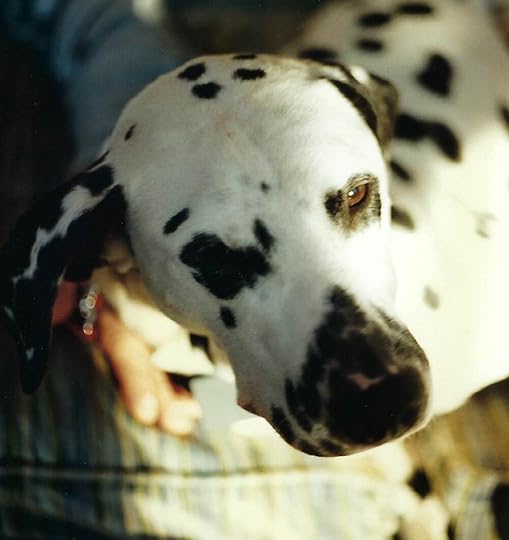
1. Rubbing Their Noses In It.
When we think about it, we use the bathroom during the 6 – 10 hours that we are at work or home, right? Chances are our dog also has to go during that time, and sometimes he or she may not be able to hold it. Once a dog is potty trained, accidents in the house can be a sign of distress, physical illness, or simply going too long without a break.
Yelling or “rubbing their nose in it” will not teach our dog to potty outside, but it will teach him to fear us and unnecessarily hurt his feelings.

2. Our pups need to play
It’s one thing to halfheartedly pat our pup on the head as we breeze through the door with an armload of groceries. It’s quite another to set aside designated one-on-one time. No matter how busy our life is, it’s important to prioritize time to do something our dog enjoys. Whether it’s 10 minutes of fetch, a nice evening walk or just cuddle time on the couch, a dog’s level of happiness depends on the attention they receive from us, their favorite humans.
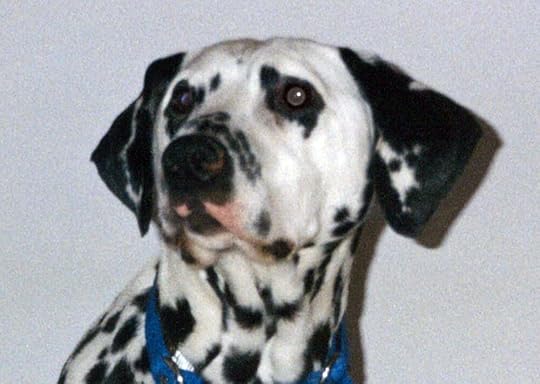
3. Punishing fearful behavior
Cowering, raised hackles, flattened ears, tucked tails and growling are all signs that our pup is not comfortable in a particular situation. What they need at these times is to be calmly and quietly removed from the upsetting stimulus. Yelling and over-assertiveness on our part will only escalate the situation. Fearful behavior can often be mistaken for aggression in dogs and vice versa, so if this is an issue we are dealing with, contact a professional trainer.
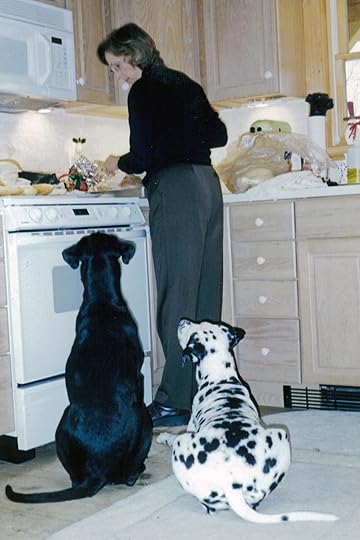
4. Being Inconsistent With The Rules
We are probably all guilty of this from time to time. It doesn’t matter whether we have one household rule for our dog or fifty. What matters is remaining consistent. If sleeping on the furniture is a no-no, don’t decide to let our pup snuggle on the bed while we’re sick, then punish him the next day when he hops up for a nap! The same goes for leash-pulling, begging and jumping up.
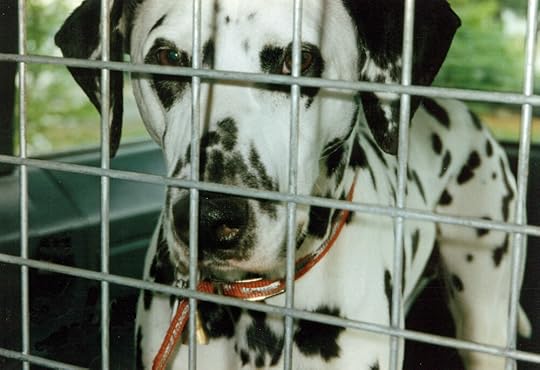
5. Segregation From The Pack
MOST IMPORTANTLY TO KNOW is that our dog will be hurt most by keeping him away from his family. Remember, we are his whole world! Some owners are unable or unwilling to provide the necessary training that dogs need in order to understand what is expected of them. These misunderstood pups are labeled “bad” and isolated to a kennel or backyard – possibly even abandoned.
Our precious pups want to make us happy. More than treats or toys, they crave our love and approval. If anyone is having trouble with our dog’s behavior, we must be responsible and attentive. We MUST seek professional help from our veterinarians or an experienced dog trainer.



